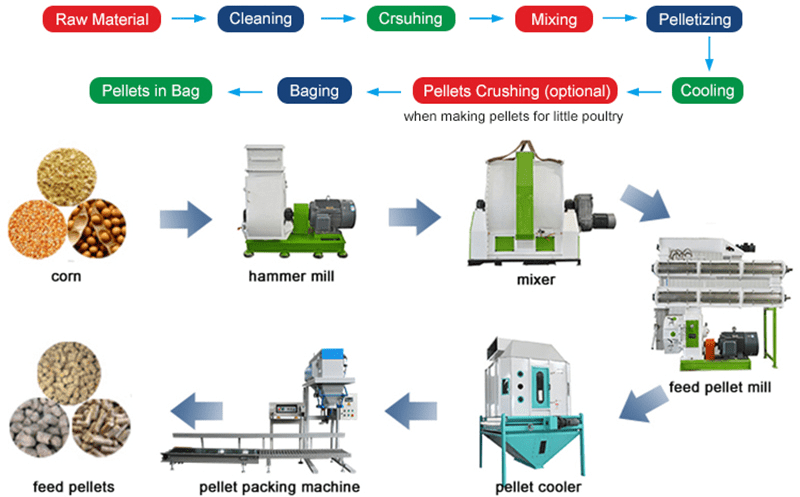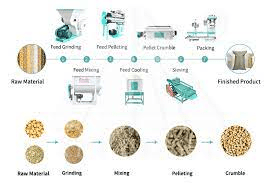The process of manufacturing animal feed is a means whereby raw materials of widely ranging physical, chemical and nutritional composition can be converted into a homogenous mixture suitable for producing a desired nutritional response in the animal to which the mixture is fed.
The process is basically a physical one and chemical changes are few. It should be remembered however that some raw materials will have undergone extensive processing prior to inclusion into a mixed feed, for example, extraction of oil from oil seeds by solvent or mechanical extraction, heat treatment of soya beans or other beans to denature anti-nutritive factors, or the production of fishmeal and meat meal.
The feed manufacturing process may be considered to be made up of several unit operations which, in almost all circumstances, include the following:
- Raw material, storage and selection.
- Raw material weighing.
- Raw material grinding.
- Mixing of dry ingredients and addition of liquids.
- Pelleting of mixed feed (optional).
- Blended feed bagging, storage and dispatch.
Feed Manufacturing Process

The manufacturing process usually start with the grinding process. Depending on the formulation, feed could contain up to 10 different components including carbohydrate, protein, vitamins, minerals and additives. The feed ration can be pelleted by proportionally homogenizing the specific compositions.
Pelleting is achieved by various methods, but the most common means is by extrusion. A hygienic environment is important during the entire process of the feed production to ensure quality feed.
When making feeds, manufacturers consider the age, production level of the animal, species and the cost of the feed. They then play around with figures using Pearson Square method or a computer software such as Win feed to attain the optimal theoretical nutritional levels of the formulated mash.
After formulation, some feeds are further processed into pellets by either hot or cold processing. Pellets are either formed using pelletisation or extrusion technologies.
Proteins and starch forms a larger percentage of these formulations. Proteins are made up of amino acids as building blocks joined together by peptide bonds. On the other hand, starch is a polymer of amylose and amylopectin monomers having both hydrogen and glycosidic bridges.
Poultry, swine and fish are monogastrics (have single-chambered stomach), therefore, rely on enzymatic hydrolysis of complex food components in the fore stomach.
Sometimes these feeds are not effectively hydrolysed. This reduces their absorbability, impairing both the growth rate and performance of animals. Therefore, further processing of the raw formulated mash is necessary.
Feed manufacturers use different processing method namely:
1. Cold processing
Feeds are processed at or lower than the ambient temperature. These processes include grinding in the hammer mill, size reduction, soaking and reconstitution of dried feeds.
These processes mostly influence the physical appearance of the feeds but less or no, modification on the chemical properties of the feeds. Feeds under these categories are the mash forms.
Read Also: Effect of Feeding Fresh Cassava and its Peels to Ruminant Animals
2. Hot processing
Heat treatment is applied to animal feeds to improve hygiene, nutritional quality and physic-chemical properties. Thermal energy is applied to either dry or wet ingredients such as soybeans or cereals. The aim here is to soften the seeds, modify the starch or denature the anti-nutrients such as trypsin inhibitors.
This procedure is common in steam rolling, roasting and steam flaking methods of feed processing. Steam flaking differs from steam rolling because of the high moisture content applied and the higher contact time.
This process has been seen to increase starch digestibility from 22.7-51.2 per cent. These feeds therefore, increase the performance of the reared animals.
3. Popping
It is a dry hot feed processing method that is applied to the seeds. This process causes sudden rapture of the endosperm. The seeds are then rolled before being fed to the animals.
4. Pelletization
It is another hot processing method. It involves grinding and formulating feed and then forcing it through a thick, spinning die with the use of rollers.
The feeds can be made in different diameters, length and hardness. This process alters the physic- chemical properties of the feeds due to the high pressure used.
Losses are minimal during feeding and transportation because the pellets do not easily break. Pelleting increases growth rate and feed efficiency by 6.6 to 7.9 per cent respectively.
5. Extrusion processing
This recent technology operates on three principles: steam conditioning, high temperature cooking and high shear pressure. The process starts by formulation and tempering the mixture to about 30 per cent moisture content.
Steam conditioning is the first step in this method. The aim of this step is to facilitate die lubrication and feed particle adhesion. This increases pellet durability index and gelatinise starch.
Broilers fed extruded pellets have a higher feed intake, this, therefore, increases live weight gain compared to those fed the mash. Extrusion combines three parameters of moisture, high temperature and pressure to modify the starch and protein enhancing their digestibility.
Read Also: Different Varieties of European Eggplant and their Characteristics
There has been better performance in swine, fish and poultry fed on extruded pellets than those fed on the mash. The better performance can be attributed to:
The heat used in feed conditioning breaks down starch into its constituent monomers that are further broken down to monosaccharaides. On the other hand proteins are broken down into smaller polypeptides.
This enhances feed digestibility due to the large surface area exposed to the enzyme hydrolysis, hence better performance of animals fed these feeds.
During pelleting, the nutrients tend to concentrate in the product and pellets are also bound together. This minimises wastage during feeding and transportation hence increasing average daily gain.
It improves energy digestibility in cereal based diets due to starch gelatinisation, unlike in the mash leading to better performance of early weaned pigs fed extruded feeds.
It also helps in improved faecal digestibility of some amino acids in chicken. Increases digestibility of proteins, amino acids and nitrogen by denaturing of the former and modifying side chains of amino acids.
Starch gelatinisation together with the above changes on proteins results in better digestibility, increase feed intake, improved feed conversion ratio and performance in chicken. Extrusion results in starch gelatinization which makes it more susceptible to amylase, this enhances starch digestibility. This improves poultry performance.
Grain Milling for Feed Preparations

Corn, sorghum, wheat and barley are the most used cereals in the preparation of feed for the livestock, poultry, swine, and fish industry. Roller and hammer mills are the two types of processing equipment generally used to grind grains into smaller particle sizes.
Milling cereal grains by mechanical action involves several forces like compression, shearing, crushing, cutting, friction and collision. The particle size of the ground cereal is very important in the animal feed production; smaller particle sizes increase the number of particles and the surface preparations area per unit volume which increase access to digestive enzymes.
Other benefits are increased ease of handling and easier mixing of ingredients. The average particle size is given as geometric mean diameter (GMD), expressed in mm or microns (μm) and the range of variation is described by geometric standard deviation (GSD), with a larger GSD representing lower uniformity.
According to Lucas (2004), GMD and GSD are accurate descriptors of particle size distribution when the particle size distribution is expressed as log data, and are distributed log normally.
Studies have shown that grinding different grains with the same mill under similar conditions results in products with different particle sizes. The hardness of a grain sample is related to the percentage of fine particles obtained after grinding, with a higher percentage of fine particles from lower hardness grains.
Rose et al. (2001) discussed that hard endosperm produces irregularly-shaped larger particles, while soft endosperm produces smaller size particles. The correlation between particle size and energy consumed is although not positive but, to obtain very fine particle sizes require higher energy which reduces the rate of production.
Moreover, a very fine grind of grain has no impact on the efficiency of pelleting, nor on the power consumed during pelleting. Amerah et al. (2007) discussed the availability of more data suggesting grain particle sizes are very important in mashed diets than in pelleted diets.
Read Also: They Different types of manure and how they work
